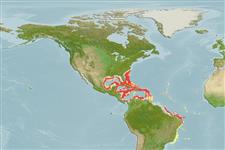Common names from other countries
Classification / Names / Names
Common names | Synonyms | Catalog of Fishes (gen., sp.) | ITIS | CoL | WoRMS
Environment: milieu / climate zone / depth range / distribution range
Ecology
Sessile; depth range 91 - 1996 m (Ref. 840). Tropical
Atlantic Ocean: Florida to the Caribbean, south to Brazil and east to Portugal.
Length at first maturity / Size / Weight / Age
Maturity: Lm ? range ? - ? cm
Maximum depth reported taken from Ref. 128739. Rio de Janeiro, Brazil to the Caribbean, from depths of 91 to 1966; bathymetric distribution from 188 to 552 m deep (Ref. 840). Inhabits lower mesophotic reefs (Ref. 128739).
Life cycle and mating behavior
Maturity | Reproduction | Spawning | Eggs | Fecundity | Larvae
Members of the class Hexactinellida are hermaphroditic. Life cycle: The zygote develops into trichimella larva (free-swimming) before settling down on a substrate where it grows into a young sponge.
Lopes, D.A., E. Hajdu and H.M. Reiswig. 2005. (Ref. 840)
IUCN Red List Status (Ref. 130435)
CITES status (Ref. 108899)
Not Evaluated
Not Evaluated
Human uses
| FishSource |
Tools
More information
Age/Size
Growth
Length-weight
Length-length
Morphology
Larvae
Abundance
Internet sources
Estimates based on models
Preferred temperature
(Ref.
115969): 5.7 - 15.2, mean 9.3 (based on 198 cells).
Price category
Unknown.
